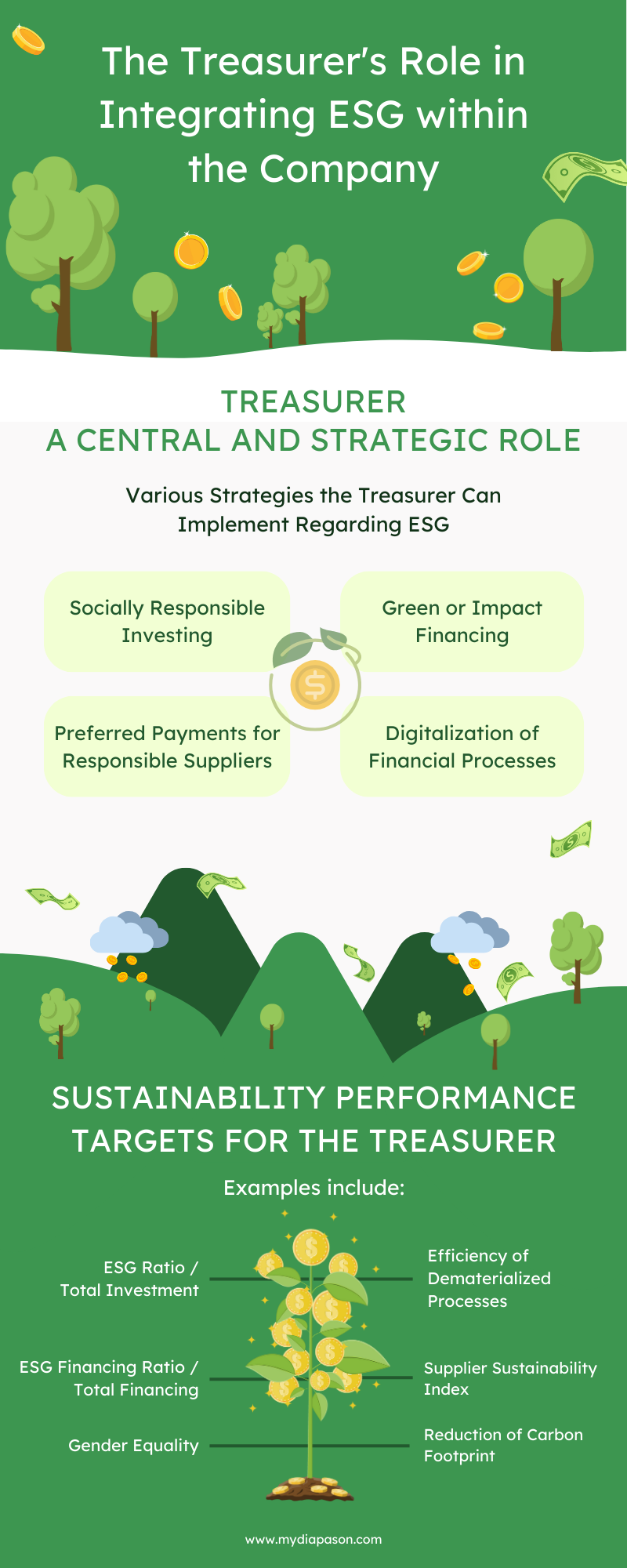
What Strategies to Implement to Promote ESG in the Company?
Financial and ESG Strategy: Explore the Treasurer’s Approaches and the Use of Sustainability Performance Targets in the Company.
ESG has become a major concern for companies aiming to position themselves as responsible and sustainable players. The treasurer, as the person in charge of managing the company’s treasury, plays a key role in aligning financial strategy with Environmental, Social, and Governance (ESG) objectives.
Explore the various approaches that the treasurer can take to incorporate ESG criteria within the company, and understand how Sustainability Performance Targets (SPT) can be leveraged as performance indicators to demonstrate a tangible commitment to sustainability.
Treasurer: A Central and Strategic Role in ESG
There are various strategies that the treasurer can implement within the company:
1.Socially Responsible Investing (SRI)
As the guardian of the company’s financial resources, the treasurer can play a crucial role in directing investments towards socially responsible options. Embracing Socially Responsible Investing involves selecting financial assets based on ESG criteria. This may entail excluding companies involved in controversial activities and promoting investments that support sustainability. The treasurer can collaborate with asset managers to integrate these criteria into the company’s investment strategy, thereby aligning financial goals with environmental and social considerations.
2.Green or Impact Financing
By directing financing efforts towards eco-friendly or socially impactful projects, the treasurer has the opportunity to receive a bonus of up to 20% on financial fees, provided that the ESG objectives related to the credits are met. Close collaboration between the treasurer and internal and external stakeholders is essential to identify and finance these initiatives, thereby demonstrating the company’s sustainable commitment. The company’s exemplary CSR policy undergoes evaluation by an independent third party to ensure the bonus is granted.
3.Preferred Payments for Responsible Suppliers
Encouraging social responsibility among suppliers is a strategic way to establish sustainable practices throughout the supply chain. The treasurer can develop favorable payment policies for suppliers who adopt responsible practices in the social, environmental, and governance aspects. This incentivizes business partners to align their operations with ESG standards, thereby creating a more sustainable and ethical ecosystem.
4.Digitalization of Financial Processes
The digitalization of financial processes is a powerful ESG lever for treasurers to demonstrate their commitment to ESG goals.
The adoption of tools such as a Treasury Risk Management System (TRMS) particularly promotes the reduction of paper usage in daily interactions, facilitates the digitization of transaction confirmations, utilizes electronic signatures, and dematerializes processes related to bank power management.
By embracing these measures, treasurers can play a crucial role in transitioning towards more sustainable financial and operational practices.
The Treasurer’s Sustainability Performance Targets
Sustainability Performance Targets (SPT), or sustainability performance objectives, serve as crucial benchmarks for companies aiming to assess and enhance their performance in terms of social, environmental, and governance responsibility. In this context, the treasurer plays a vital role in establishing key performance indicators (KPIs) such as:
1.Socially Responsible Investment (SRI) Ratio / Total Investment
The treasurer can establish a key performance indicator (KPI) by measuring the Socially Responsible Investment (SRI) Ratio in relation to the total investment of the company. This ratio illustrates the financial involvement of the company in socially responsible initiatives. By tracking this KPI, the treasurer can assess the company’s progress toward a more sustainable investment strategy, providing visibility into the financial impact of ESG decisions.
2.Efficiency of Dematerialized Processes
The adoption of dematerialized processes provides both environmental and operational advantages. The treasurer can establish KPIs related to the efficiency of these processes, such as reduced processing time, decreased errors, and improved operational fluidity. These quantifiable measures demonstrate the company’s commitment to sustainability while enhancing the responsibility and efficiency of financial operations.
3.ESG Financing Ratio / Total Financing
To assess the impact of financing operations on ESG initiatives, the treasurer can establish an ESG financing ratio in comparison with the total financing of the company. This ratio evaluates the proportion of resources dedicated to socially responsible projects in relation to overall investments. By monitoring this measure, the treasurer can adjust the financing strategy to better align financial support with the company’s ESG objectives.
4.Supplier Sustainability Index
One way to promote sustainability in the supply chain is by creating a Supplier Sustainability Index. The treasurer can assess suppliers based on ESG criteria, such as adherence to social and environmental standards, transparency, and commitment. This index allows measuring the company’s contribution to preserving the planet and improving living conditions, while encouraging suppliers to adopt more responsible practices.
5.Gender Equality
The treasurer can measure the promotion of gender diversity within the treasury team based on a gender balance indicator.
6.Carbon Footprint Reduction
The carbon footprint of the company’s financial activities is a crucial indicator for the treasurer. They can actively contribute to environmental protection by implementing actions to reduce greenhouse gas emissions associated with financial operations. This may include carbon offsetting, adopting renewable energy sources, limiting travel, and automating processes to achieve a paperless environment. In this way, the treasurer supports the company’s ecological objectives.
The treasurer’s adoption of Sustainability Performance Targets (SPT) reflects the company’s commitment to acting sustainably and socially responsibly. By implementing specific indicators, the treasurer can regularly assess the company’s performance based on ESG criteria. These actions not only improve transparency and efficiency in financial activities but also position the company on a sustainable trajectory in line with ethical and environmental standards. Therefore, the treasurer’s integration of SPT represents a significant contribution to building a more responsible and sustainable financial future.
About the Author
Célia Tinoco, Marketing and Communication Officer
Célia has joined the Marketing team as a Marketing & Communication Officer. In the content area, she writes in-depth and timely articles on topics related to the treasurer’s profession. Her goal is to provide treasurers with insights to better master their treasury management and support them in their daily tasks.



